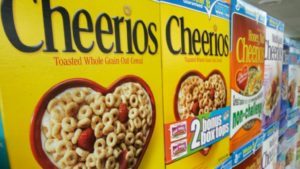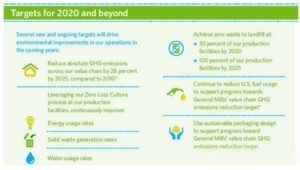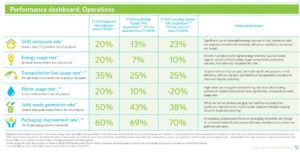The environmental impact behind a cereal box: How General Mills is addressing climate change
General Mills is the manufacturer of a wide portfolio of products, such as baking mixes, breakfast cereals, yogurt and ice-cream, and has very popular brands such as Cheerios, Yoplait and Haagen Dazs.
During the last few years, General Mills has been expressing its concern about sustainability and climate change, and in 2015, announced a formal commitment with quantitative targets and action plan.[1]
Why is General Mills concerned about climate change?
It may seem that General Mills’ business is not related or would not be affected by climate change. However, there are some important reasons that support why the company is addressing this problem.
First, many General Mill’s products depend on agriculture, using cocoa, corn and wheat as main raw materials. Climate change and the emission of GHG has negatively impacted the availability of these supplies, becoming a risk for business.[2]
Second, the use of clean energy can help reduce costs, thus improve products profitability. The company stated that they are using clean energy from oat hulls in their oat mill in Fridley “reducing the mill’s carbon footprint by 21 percent and saving more than $350 million in natural gas costs. In Guangzhou, China, General Mills reduced emissions by more than 25 percent after switching from oil to natural gas.” The company forecast that “this will save about $1 million yearly at the Guangzhou site alone.”[3]
Third, activists are generating a lot of pressure to big companies, demanding sustainable policies and tracing their implementation[4]. On one hand, sustainability and environmental concern can be part of a company’s strategy and can become a competitive advantage because generates goodwill in consumers. On the other hand, not being sustainable can lead to bad publicity and can destroy a company’s reputation.
A commitment with the future
In 2015 General Mills announced a series goals[5] to address climate change problems. It’s important to point out that the company’s efforts will impact the whole supply chain, from agriculture to the retails. In the corporate web page, the CEO of the company stated: “We know our greatest impact is outside our four walls – particularly in agriculture, ingredients and packaging. To reduce emission levels, we must work across our value chain with growers, suppliers, customers and industry partners. Together, we will identify new solutions and promote sustainable agriculture practices that drive emission reductions.”6
General Mills found that most of the GHG emissions and water consumption comes from its raw materials, particularly, from agriculture6.
For this reason, the company stated its commitment to sustainably source 100% of its 10 priority ingredients by 2020. These ingredients represent more than 50% of the annual raw material purchases. To accomplish the target, the company is building partnerships with suppliers to accelerate adoption of more sustainable agriculture practices that build climate-resilient, healthy soils.[6]
In addition, the company its changing its internal operations to reduce GHG emissions, energy consumption, transportation fuel, water consumption, and solid waste.[7]
Is that enough?
Even though General Mills’ policy regarding climate change is a great step to fight greenhouse emissions and climate change, there is still space to generate improvements, such as:
- Have stronger policies regarding other raw materials such as palm oil, as “when deforestation occur to make way for oil palm plantations, the sequestered carbon is released into the atmosphere as carbon dioxide, contributing to global warming.”[8]
- Establish guidelines and controls to guarantee the reduction of GHG emissions on agriculture. It’s not only important to build partnerships, but also to trace the source of raw materials and have the mechanisms to control and report the reduction of GHG emissions.
- Evaluate changes in the portfolio of products to decrease the diary consumption, because “a cow does on average release between 70 and 120 kg of Methane per year. Methane is a greenhouse gas like carbon dioxide (CO2). But the negative effect on the climate of methane is 23 times higher than the effect of CO2.”[9]
- Raise the environment concern in retailers and consumers, who are the last pieces in the supply chain. (784 words)
Endnotes
[1] General Mills. 2015. General Mills announces new commitment on climate change. [ONLINE] Available at: https://www.generalmills.com/en/News/NewsReleases/Library/2015/August/Climate-Commitment.
[2] The Huffington Post. 2015. General Mills Warns Climate Change Will Lead To Global Food Shortages. [ONLINE] Available at: http://www.huffingtonpost.com/entry/general-mills-warns-climate-change-will-lead-to-global-food-shortages_us_55e45e5ce4b0c818f6186305
[3] Environmental Leader. 2015. Why General Mills, Dell, Unilever care about the COP21 Climate Talks. [ONLINE] Available at: http://www.environmentalleader.com/2015/11/04/why-general-mills-dell-unilever-care-about-the-cop-21-climate-talks/#ixzz4P23Qx9yC.
[4] Los Angeles Times. 2014. General Mills drops GMOs from Cheerios. [ONLINE] Available at: http://www.latimes.com/business/la-fi-cheerios-gmo-20140104-story.html.
[5] https://www.bsr.org/our-insights/blog-view/how-general-mills-worked-with-bsr-to-set-climate-targets
[6] General Mills. 2015. General Mills announces new commitment on climate change. [ONLINE] Available at: https://www.generalmills.com/en/News/NewsReleases/Library/2015/August/Climate-Commitment.
[7] General Mills. 2015. Our approach. [ONLINE] Available at: https://www.generalmills.com/Responsibility/Environment/environment-approach.
[8] Union of Concerned Scientists. 2015. Palm Oil and Global Warming.
[9] Time for Change. 2008. Are cows the cause of global warming?. [ONLINE] Available at: http://timeforchange.org/are-cows-cause-of-global-warming-meat-methane-CO2.







D, I appreciated how you raised that pressure from activists and expectations from consumers can be a motivator for organizations to join the sustainability movement. Cynically, I am disappointed that organizations are not adequately motivated by the impending depletion of our planet’s resources to start acting; but at the same time, I am grateful that this strong social pressure has been effective in mobilizing large corporations. I am left wondering – does it even matter why an organization started taking action? Or from another perspective, how can we strengthen this social pressure to drive the stragglers to join the movement?
Thanks for this post. Really interesting to see how climate change is affecting a category like cereal. The point on decreasing dairy consumption is interesting – I wonder if this responsibility lies with General Mills because of it’s position or if the milk producers and farmers have a role to play as well. This does lead me to think however, that even if we decreased dairy consumption, would this impact the methane levels? Wouldn’t the cows continue to release methane?
I am happy to see that Mills is setting actionable targets to decrease their footprint. I think it’s a really important piece that brand managers now have to consider as they manage the P&L of a brand. I also think it’s important from a competitive standpoint for Mills to set the standard and raise the bar, given how large they are and how much power they have.
Thanks for the post!
It is admirable that General Mills is trying to reduce it’s carbon footprint and take a stand against climate change. I am wondering what type of effect this has on the company’s cost of goods sold and whether or not this is sustainable for them to maintain their low everyday prices. You mentioned in the post that the use of clean energy can reduce costs- but for who? I imagine that the engineering involved in finding new methods for processing their ingredients is very costly and it is difficult to source from “clean” places. Do you think General Mills is using these changes to increase positive PR or are they truly concerned about sustainability in development as our world changes?
Thanks for the thought provoking post. Great job!
Great article! One point I wanted to challenge is your suggestion regarding less dairy consumption because of the methane released by cows. Although I see your point, it is worth pointing out that cows are part of the natural cycle and for many farmers, are a “healthy” way to clean up arable land. Also, to many farmers, dairy consumption is the source of nutrients needed to stay healthy given the lack of healthy food alternatives. What I am getting at is that the benefits might outlay the negatives, although this is just a thought as I do not have exact figures to confirm my logic.